Feature
Growing STEM Learning Opportunities With Agriculture
Connected Science Learning October-December 2020 (Volume 2, Issue 4)
By Brian McNeill, Kirstin R. Koch, and Becca Turnquist
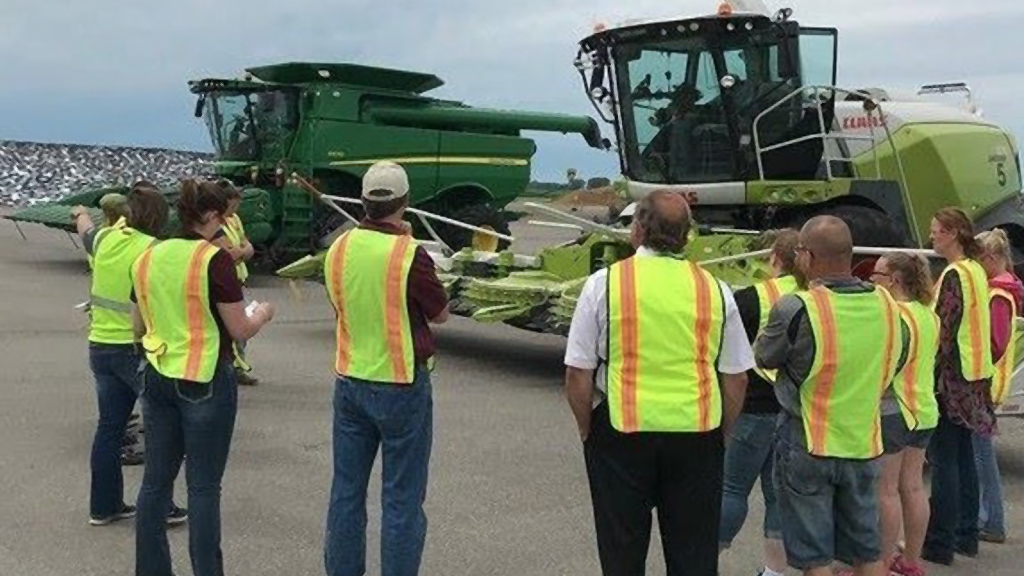
Our lives are completely immersed in science and technology. People with science, technology, engineering, and math (STEM) skills are better consumers of science and technology and may become the next scientist or engineer whose work makes a big difference in people's lives. For more than a century, the 4-H program has engaged youth in STEM activities by providing outreach from the land grant university system to youth through learning opportunities such as out-of-school time programs. This engagement has traditionally provided a focus on agricultural science, electricity, mechanics, entrepreneurship, and natural sciences. Today, 4-H has grown to include rocketry, robotics, biofuels, renewable energy, computer science, environmental sciences, and more.
The University of Minnesota Extension 4-H Youth Development programs’ focus on STEM has grown into opportunities for youth to explore agronomy and horticulture. These experiences reach more youth by engaging them in out-of-school time experiences. In the Minnesota 4-H Agronomy & Horticulture programs model “Plant - Learn - Grow,” youth gain 21st-century skills by growing plants to enhance learning while exploring the agriculture business.
Agronomy is the science of using plants for food, fuel, feed, and fiber, while horticulture is the science of growing fruits, vegetables, and flowers. Agronomy and horticulture are unique because they combine sciences like biology, chemistry, ecology, Earth science, and genetics. The 4-H program offers specific project areas connected to agronomy and horticulture. Those project areas include Crops, Plant and Soil Science, and Vegetable Gardening. The 4-H Agronomy & Horticulture program is designed to provide youth with opportunities to expand their knowledge while learning about the many facets of agronomy and horticulture. The program uses inquiry to introduce youth to the properties of the soil and how the soil interacts with the growing crop. Youth can explore what nutrients the crop needs and when and how to apply these nutrients; the ways that crops grow and develop; how climate and other environmental factors affect the crop at all stages; and how best to control weeds, insects, fungi, and other crop pests.
The Need for Agriculture and Horticulture Programming in Out-of-School Time
Important, in-depth learning takes place every day in the classroom setting; however, “only 5% of learning over a person’s lifespan takes place inside of a classroom, leaving the other 95% to out-of-school settings such as museums, organized programs, hobbies, television, and other sources” (Falk and Dierking 2010, p. 486). School science classes cover a broad range of topics in a limited amount of time. 4-H STEM educational opportunities allow youth to explore their classroom learning in-depth, especially in agronomy and horticulture projects.
“Numerous strengths make these learning environments ideal to spark curiosity for learning: options and choices for learners, the potential for community involvement, and emphasis on youth development. Out-of-school time environments tend to be fun, enjoyable, relevant, and engaging, leading to higher levels of intrinsic motivation.” (Mahacek and Workers 2013)
Additionally, out-of-school programs can provide safe, stable, and nurturing learning environments that provide more opportunities for student growth.
There is a continued need for out-of-school programming, especially programs connected to agriculture literacy, which is defined as understanding and possessing knowledge of our food and fiber system. Agricultural education courses are generally classified as electives. “Because of this, there is a lack of established curriculum, standards, and objectives for middle school agricultural education. This lack of materials and information puts the responsibility of creating curriculum on individual program teachers” (Sunderman 2019, p. 3).
4-H programs are grounded in the belief that kids learn best by doing. Youth complete hands-on projects involving science, health, agriculture, and civic engagement in a positive environment where they receive guidance from adult mentors and are encouraged to assume proactive leadership roles. Youth can concentrate on one focus area or participate in a variety of programs throughout their 4-H experience.
Agricultural education programs, such as 4-H Agronomy & Horticulture, are preparing the next generation of problem-solvers, leaders, and agriculturalists through relevant, engaging curriculum and real-life experiences. These hands-on experiences include the science, business, and technology of plant and animal production, and environmental and natural resources systems management. By working together, schools, communities, and families can equip youth to lead the workforce.
Reimagining the Opportunities
In developing a successful program, a variety of factors needed to happen: recruiting early adopter committee members; collecting and using data; getting input and buy-in from program participants; and keeping a high level of momentum from educators, volunteers, and participants. The 4-H Agronomy & Horticulture pilot program was launched in Minnesota in December 2017 to reimagine the opportunities available to youth (kindergarten through one year after high school). We first identified a steering committee of Extension staff from the areas of youth development and crop specialties with a variety of backgrounds and interests. The steering committee developed a program plan outlining a five-county pilot in year 1, a 28-county regional pilot in year 2, and a statewide program in year 3 (Figure 1).

To gauge interest in the Agronomy & Horticulture program and provide direction, we distributed an online needs assessment to 4-H youth members in the five pilot counties. Questions included:
- What types of support do you need in the project area?
- What would you like to learn about?
- What would help you get started?
- Are the current support pieces relevant today?
Program priorities were identified based on the 290 responses. The top priorities included agronomy project kits, agronomy tours, and career opportunities. Using this information, the steering committee developed a variety of learning opportunities for youth.
Steering committee staff encountered a number of challenges along the way. The first challenge was finding time to devote to the initiative. Steering team members had other job duties, and providing real focus was challenging. The committee also had issues with management of the project kits—the process of ordering, assembling, and delivering the project kits was overwhelming. Another challenge was updating current support materials and creating new support materials. Being aware of these challenges helped the committee focus and organize its work to move the initiative forward.
The needs assessment data also showed interest in agronomy and horticulture from youth of both genders, uncovered large gaps in purposeful programming pertaining to youth of all ages, and showed a need for updating materials and program offerings. As programs and opportunities were developed, a natural sequence began to take place that supported development in early elementary grades, middle school, and high school. As the program pieces fell into place, a program model was identified: Plant - Learn - Grow.
Program Model: Plant - Learn - Grow
The sequential steps of the experiential learning model (Figure 2) help youth identify what they have learned from a 4-H experience or activity and apply that learning to other situations. This model requires that the teacher/leader be very clear about the skills targeted and that the experience and the processing questions are designed to support the learner’s goal. The experiential learning process engages the learners in all phases of the activity, resulting in the ability to generalize this learning to new situations.
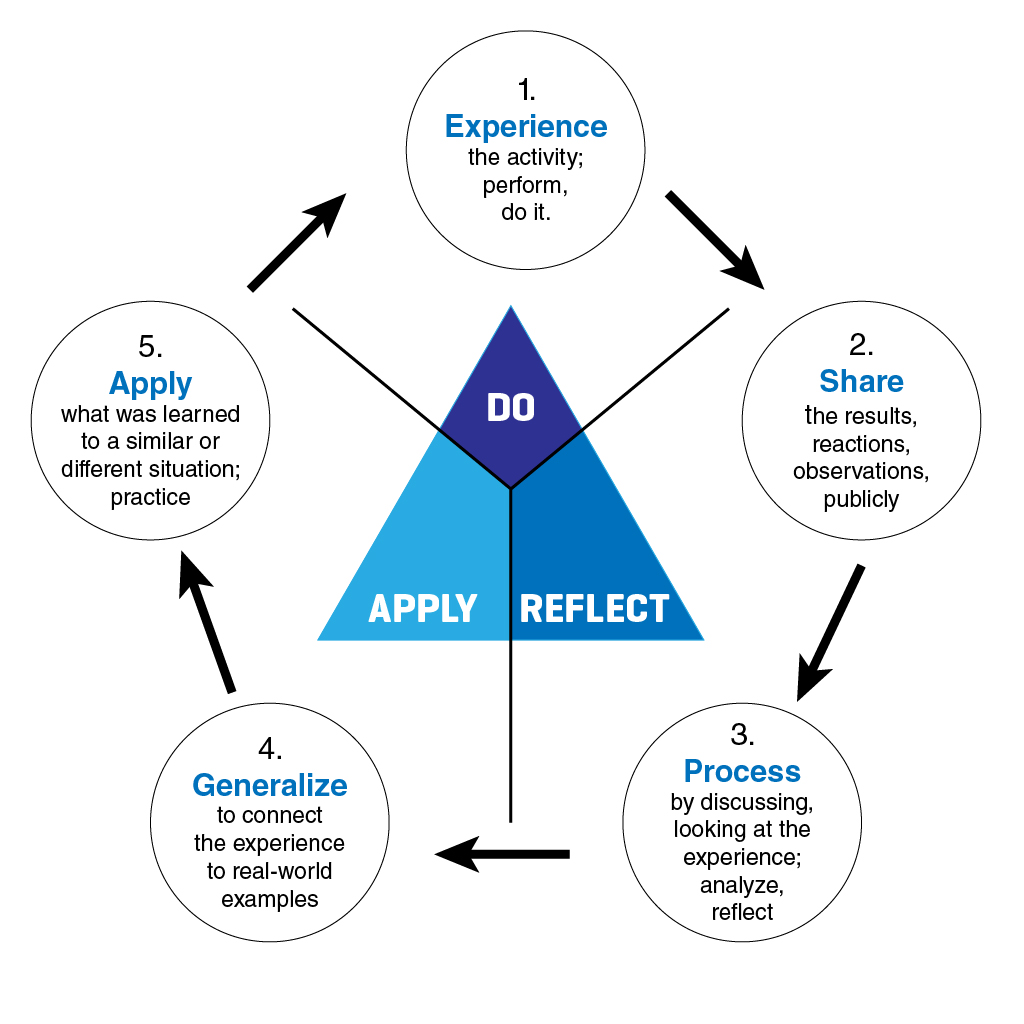
The 4-H Agronomy & Horticulture program model supports the experiential learning process at several stages, including planting, learning, and growing. The program provides start-up kits for youth to explore growing a plant. When using a start-up kit, youth first learn about plants (Experience). Next, they share their growing project with their 4-H club or other caring adults (Share). Then, they continue to observe their plants grow and discuss questions with their parents or other adult experts (Process). They can also relate their experience to a job or further education (Generalize). After their plant has grown, they have opportunities to share their experience at a county fair or think about their next step for the coming year (Apply).
The Minnesota 4-H Agronomy & Horticulture program model was developed to engage youth at an early age and provide opportunities to be involved for many years; youth can grow with the program as they explore agronomy and horticulture, dive deeper into their learning, and grow as leaders. The program’s scope and sequence gives youth the opportunity to “Plant” their ideas, “Learn” about the next steps in life, and “Grow” while they use their skills (Table 1).
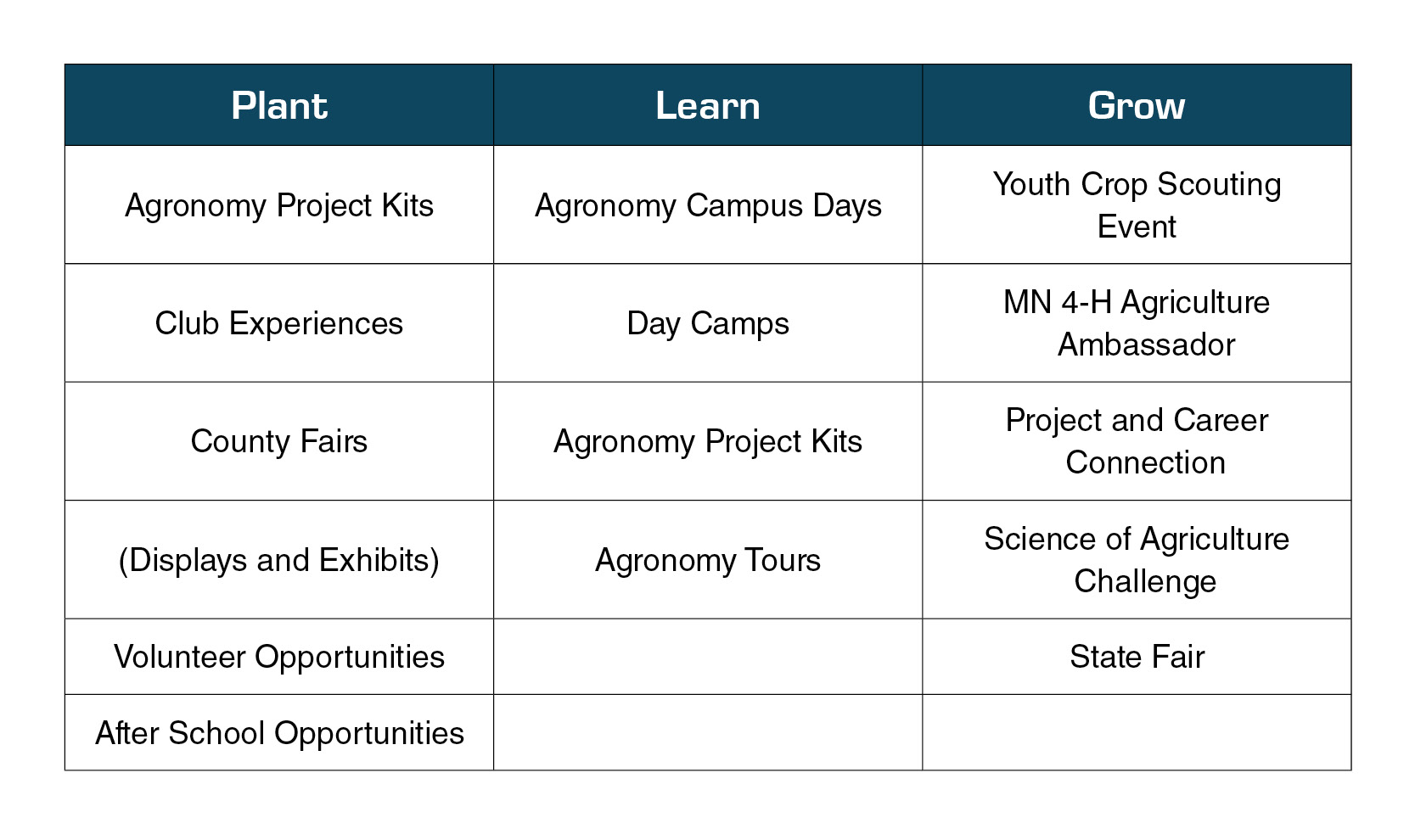
This program model can be easily replicated in classrooms and other educational settings. Many of the resources created and details on the different levels of the model are available at extension.umn.edu/projects-and-more/4-h-agronomy. Several strategies and resources are explored in more depth in the following sections.
Program Ideas and Strategies
Agronomy Project Kits
The Agronomy & Horticulture Project Kits allow youth to experience growing a plant no matter where they live or whether they have access to the ground (Figure 3). The kits are designed for youth in elementary school as an introduction to the “Plant” stage of our model. Through the Agronomy & Horticulture project kits, youth learn about and experience growing a plant, reinforcing in-school learning through an out-of-school time experience. Kits include seeds, a five-gallon bucket, a clear tote or pot, a support guide, and an evaluation to collect data and measure impact. Youth were encouraged to keep a journal to record their process, observations, and findings. The process of growing a plant using the kits could easily be replicated in a classroom science experiment, other out-of-school time programs, or at home as a STEM experience. When offering the kits, we saw a 47% increase in participation from year 1 to year 2; as a result, new kits are being created and offered to meet the demands of family interest. In year 3, data also showed 20% of the youth participated for more than two years. Agronomy & Horticulture project kits are a small investment for families as the materials needed are minimal and low cost. Sponsors, such as local agribusinesses, supplied some of the materials (e.g., five-gallon buckets).

After growing a plant, youth can expand on their learning by turning their Agronomy & Horticulture project kit into a science experiment. Some examples of expanded learning may include experimenting with sunlight, fertilizer, water, and different seed varieties, or introducing a new variable. For more information about 4-H Agronomy & Horticulture kits, see Table 2 or go to extension.umn.edu/projects-and-more/4-h-agronomy.
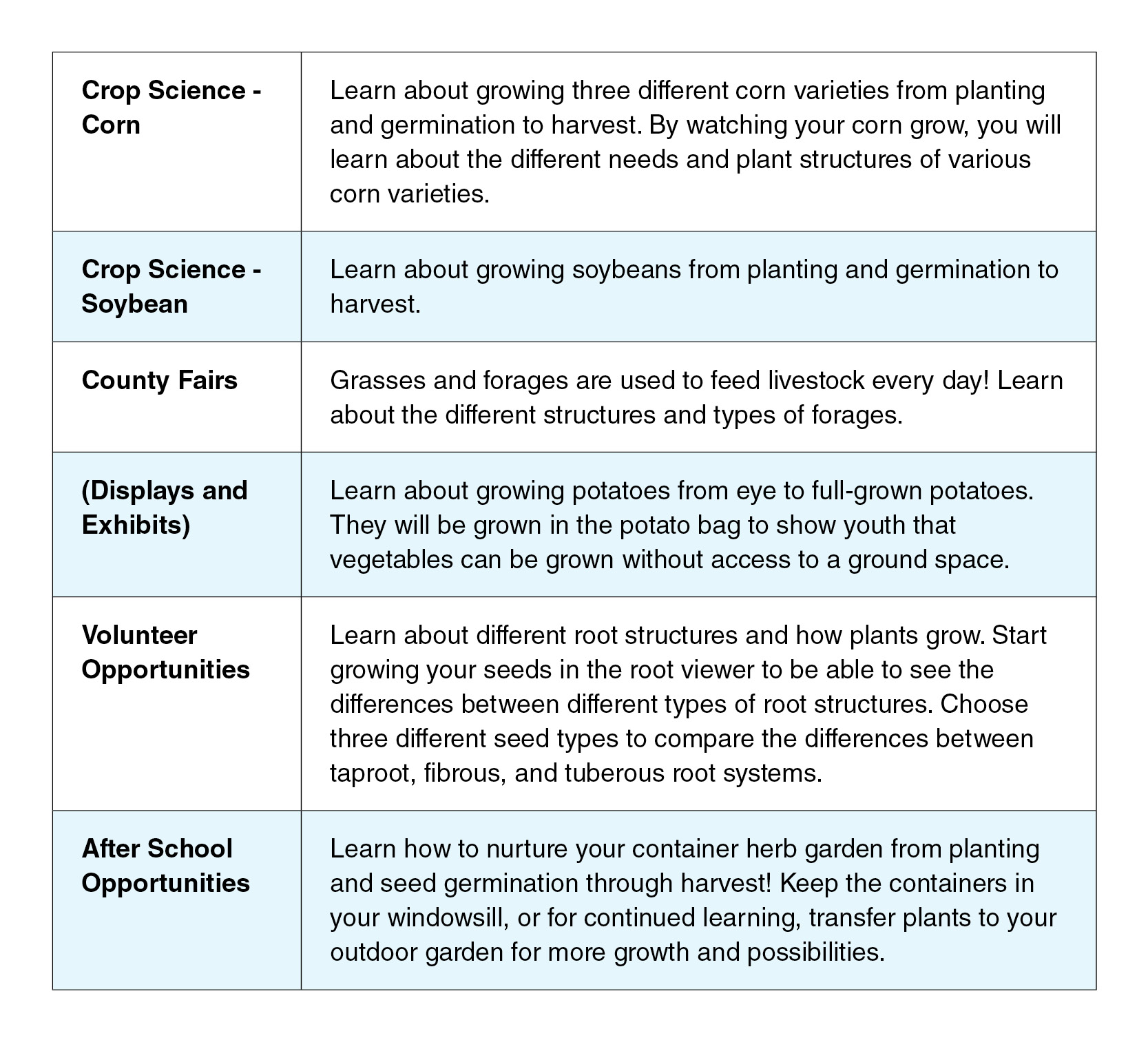
Adventures: After School or Summer
To provide fresh opportunities for STEM learning, Minnesota 4-H offers Agronomy Adventures to further support structured out-of-school time learning, either after school or in the summer. Agronomy Adventures focus on familiarizing youth with agronomy concepts to support the Plant and Learn phases of the Minnesota 4-H Agronomy & Horticulture program model. The delivery time can vary from an hour after school to a full-day.
Below are a few Agronomy Adventures Minnesota 4-H has offered:
- Agronomy & Horticulture Zoom Series: Youth across Minnesota were invited to join us to explore the exciting world of agriculture! Over 500 youth attended from Minnesota, North Carolina, North Dakota, Pennsylvania, South Dakota, Wisconsin, and Texas. At each session, youth explored a new, exciting topic, from animal agriculture to crops and everything in between!
- Crop and Soil Fun: Youth learned about different soil types, how corn and soybeans are raised, and how crops are used to feed people and animals.
- Come Grow With Us: 4-H partnered with the local Minnesota Extension Master Gardeners adult volunteers to explore the world of horticulture and growing food for people to eat.
Agronomy Campus Day
Minnesota 4-H has successfully worked to provide a connection to higher education by collaborating with new partners in higher education. Minnesota 4-H developed a daylong, campus immersion experience for school-age youth; the event includes hands-on agronomy-focused workshops and career exploration opportunities for youth. This “Learn Stage” activity was designed to introduce middle school youth to various educational offerings. Identifying higher educational institutions with a focus on agriculture or agriculture departments was essential when thinking about the partnership. Establishing relationships with faculty and providing information to support and champion the program was another important step. Other supports such as farm equipment dealers and agronomy industry professionals further enhanced the learning with content expertise, equipment, and funding. Creating and nurturing these partnerships were key to the success of the Agronomy Campus Day experience. In year 2, over 50 youth in grades 3–12 attended the campus experience, with some driving over two hours to attend.
Agronomy Tours
An Agronomy Tour (Figure 4) provides youth and parents an opportunity to interact with industry professionals in the workplace. Minnesota 4-H developed these daylong tours to provide a deeper learning opportunity for youth in third grade and older and their parents. This experience brought to life the experiential learning process. Youth had the opportunity to learn about various agronomy-related businesses (Do), ask questions of professionals (Reflect), and experience the agronomy business sector firsthand (Apply). When planning for a successful event, Minnesota 4-H considered a mix of large group tours, speakers, and small-group activities. Potential tour destinations can include local grain elevators, seed dealers, grain processors, ethanol production plants, or specialized farm operations. Interactive, hands-on activities at each tour enhanced participant learning (e.g., drone technology, 3-D plot tours/virtual reality, weed identification, crop staging demonstrations, and soil testing).
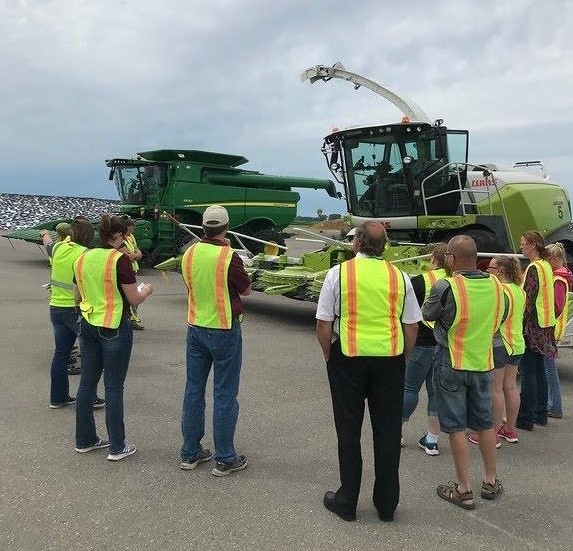
Exposure to agronomy in this format is sure to spark or continue the conversation between youth and parents about potential careers in an agricultural field of study. Providing this opportunity fits nicely with our “Learn Stage” section of the model. Agronomy Tours could be taken a step further: Provide opportunities to explore how farming is different in another region, or coordinate an exchange program where youth from rural areas can experience agronomy in an urban area and youth from an urban area can experience agronomy in a rural area.
Youth Crop Scouting
Conducting a national agronomy search, Minnesota 4-H discovered a larger initiative in the midwestern states of a 4-H and FFA Crop Scouting event and joined the initiative. A crop scout inspects farmers’ fields and records weed, insect, disease, and other observations to make recommendations that help farmers make timely, informed, and economical field crop decisions. After identifying that youth would be interested in such an event, Minnesota 4-H created a statewide experience that connected to the larger multi-state event. The event is designed to engage 4-H youth in a hands-on way to learn about crops in a deeper capacity. Providing opportunities for older youth to demonstrate and practice their learning is an important piece of the model and supports our “Grow Stage.” Teams of three to five youth (seventh grade through one year out of high school) worked with two adult volunteer coaches to learn about and develop their skills as crop scouts (Figure 5).
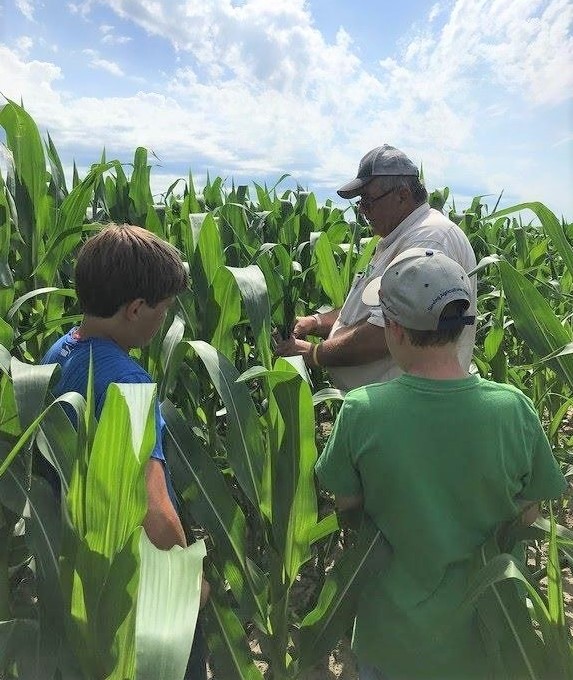
The 4-H Crop Scouting event challenged youth to learn about the following topics: crop staging, plant pathology, insect identification, weed identification, and sprayer nozzle application. This experience is directly related to career opportunities in agriculture and agronomy. Additionally, crop scouting aids in bridging the summer learning gap as it exercises the recall of biology and Earth science topics as youth study plant pathology, soil structure, and insects. In year 2, volunteer coaches in one participating county increased participation by over 50%, which required them to add a second team.
Moving Forward
The 4-H Agronomy & Horticulture program in Minnesota has grown from a five-county program pilot in 2018 to a standard part of the Minnesota 4-H Program in all 87 counties in 2020. Due to the increased agronomy offerings in 2018, enrollment in 4-H project areas related to agronomy increased by over 60% from 2017 and continues to grow.
The program has sparked an interest for many youth, volunteers, and potential partners. One of the most successful components of the program is the Agronomy & Horticulture project kits. Youth who used the kits report appreciating the opportunity to “try something new that I would have not tried on my own.” Evaluation data shows that 85–100% of participants were new to learning about these specific subject areas and that participants often took their project guides and adapted them to explore the topic in more depth. Minnesota 4-H learned that even when the projects may not have turned out how the youth anticipated, there were opportunities for continued learning; for example, a member who tried the corn kit shared, “My corn had a disease, so I made a book about corn diseases.” Through these project kits, youth explored the world of agronomy, using the experiential learning model to take their projects from the planning stages to harvest.
Several key factors have been identified as essential for program success, driving the growth of agronomy and horticulture learning in 4-H: partnerships, program funding, volunteers, and youth and family interest.
- Partnerships with professionals with diverse backgrounds have been key to this program. Local community and technical colleges, industry representatives, and financial sponsors have been key partners, as they have increased the reach of the program and provided excellent learning opportunities. Partners such as agronomists and college faculty have provided content and hands-on learning opportunities for youth participants. For example, our program has found success with partnerships through our collaboration with a local community and technical college for our Agronomy Campus Day experience. The college provided a location for our event, and faculty provided hands-on experiences for youth participants and were an integral part of the planning process. From this partnership, faculty have continued to serve as mentors, volunteers, and advocates for our 4-H Agronomy & Horticulture program. From providing funding, resources, and volunteers, partners will help support and sustain programs that are important to their interest.
- Program funding with industry and agriculture professionals and partners has been key to growing this program. Businesses in rural Minnesota have been eager to support agriculture programming designed for youth.
- New volunteers have contributed to the growth of this program and will continue to expand the reach of the program. As the program continues to grow, Minnesota 4-H plans to expand partnerships with fruit and vegetable educators and the food production industry to increase reach into urban audiences.
- Youth and family interest have been key to driving participation and growth of the Minnesota 4-H Agronomy & Horticulture program. Youth and volunteers have responded positively as shown by increased participation in organized agronomy events, such as tours and self-directed learning through project kits and fair exhibits. For example, in three years we documented 516 youth ordering 924 project kits. That was a 21% increase in project participation in just three years of offering agronomy and horticulture project kits. Minnesota 4-H also noticed an increase in project learning areas such as crop sciences with a 52% increase of member participation in a specific content area.
Moving forward, Minnesota 4-H can see the potential growth for this program to be replicated in many other learning experiences both in- and out-of-school settings. After implementing this program for two years, the 4-H Agronomy & Horticulture program is well on its way to growing program participation and enhancing opportunities for youth to explore agronomy and horticulture.
Brian McNeill (mcnei006@umn.edu) is an extension educator at the University of Minnesota Extension, Center for Youth Development in Morris, Minnesota. Kirstin R. Koch (kochx040@umn.edu) is a local extension educator at the University of Minnesota Extension, Center for Youth Development, Stevens County in Morris, Minnesota. Becca Turnquist (turnq069@umn.edu) is a local extension educator at the University of Minnesota Extension, Center for Youth Development, Swift County in Benson, Minnesota.
Resource
https://extension.umn.edu/projects-and-more/4-h-agronomy
citation: McNeill, B., K.R. Koch, and B. Turnquist. 2020. Growing STEM learning opportunities with agriculture. Connected Science Learning 2 (4). https://www.nsta.org/connected-science-learning/connected-science-learning-october-december-2020/growing-stem-learning
General Science Instructional Materials Learning Progression Life Science STEM Informal Education


